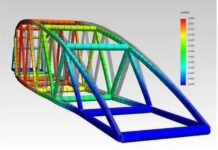1.1 Introduction
A structure is stable when it maintains balance in force and moment. As a result, we know that from statics, if a structure is to be at equilibrium;
∑Fy = 0; ∑Fx = 0; ∑Mi = 0; ——————- (1.1)
Where;
∑Fy = Summation of the vertical forces
∑Fx = Summation of the horizontal forces
∑Mi = Summation of the moment of force components acting in the x-y plane passing through point i.
When the number of constraints in a structure permits the use of equation of statics (equation 1.1) to analyse the structure, the structure is said to be statically determinate. Otherwise, it is statically indeterminate, and additional equation which is derived from load-deformation relationship is used for analysis. For the records, there are two well known approaches to the analysis of indeterminate structures and they are;
1. Flexibility Methods – When the structure is analysed with respect to unknown forces
2. Stiffness Methods – when the structure is analysed with respect to unknown displacements
A structure may be indeterminate due to redundant components of reaction and/or redundant members. Note that a redundant reaction or member is one which is not really necessary to satisfy the minimum requirements of stability and static equilibrium. However, redundancy is desirable in structures because they are cheaper alternatives to determinate structures. The degree-of-indeterminacy (referred to as RD in this post) is equal to the number of unknown member forces/external reactions which are in excess of the equations of equilibrium available to solve for them.
1.2 Determinacy of rigid frames
In rigid frames, the applied load system is transferred to the supports by inducing axial loads, shear forces and bending moments in the members. Since three components of reaction are required for static equilibrium the total number of unknowns is equal to;
U = (3 × m) + r ————— (1.2)
Since we have three equations of equilibrium, we have (3 × n) equations, hence;
RD = (3m + r) – 3n – s ————— (1.3)
Where;
m = number of members
r = Number of support reactions
n = Number of nodes
S = Number of special conditions (e.g. internal hinge)
Another equation that can be used for calculation of degree of indeterminacy in frames is;
RD = R – e – S ———— (1.4)
Where;
R = Number of support reactions
e = Number of equations of equilibrium (i.e 3)
S = Number of special conditions (e.g. internal hinge)
Whenever;
RD = 0 (structure is statically determinate and stable
RD < 0 (structure is unstable)
RD > 0 (structure is statically indeterminate)
1.3 Solved examples
In the frames shown below, classify the following frames as statically determinate or indeterminate. All internal hinges are denoted by G.
Using equation 1.3
RD = (3m + r) – 3n – s
(a) m = 6, r = 6, n = 7, s = 1
RD = [3(6) + 6] – 3(7) – 1 = 2, Hence the frame is indeterminate to the 2nd order
(b) m = 5, r = 5, n = 6, s = 2
RD = [3(5) + 5] – 3(6) – 2 = 0, Hence the frame is statically determinate
(c) m = 4, r = 4, n = 5, s = 1
RD = [3(4) + 5] – 3(6) – 1 = 0, Hence the frame is statically determinate
(d) m = 3, r = 5, n = 4, s = 0
RD = [3(5) + 5] – 3(4) – 0 = 2, Hence the frame is statically indeterminate to the 2nd order
(e) m = 4, r = 5, n = 5, s = 1
RD = [3(4) + 5] – 3(5) – 1 = 1, Hence the frame is statically indeterminate to the 1st order
(f) m = 3, r = 3, n = 4, s = 1
RD = [3(3) + 3] – 3(4) – 1 = -1, Hence the frame is unstable
Alternatively using equation 1.4;
RD = r – e – s
(a) r = 6, e = 3, s = 1
RD = 6 – 3 – 1 = 2, Hence, the frame is indeterminate to the 2nd order
(b) r = 5, e = 3, s = 2
RD = 5 – 3 – 2 = 0, Hence, the frame is statically determinate
(c) r = 4, e = 3, s = 1
RD = 4 – 3 – 1 = 0, Hence, the frame is statically determinate
(d) r = 5, e = 3, s = 0
RD = 5 – 3 – 0 = 0, Hence, the frame is statically indeterminate to the 2nd order
(e) r = 5, e = 3, s = 1
RD = 5 – 3 – 1 = 0, Hence, the frame is statically indeterminate to the 1st order
(f) r = 3, e = 3, s = 1
RD = 3 – 3 – 1 = -1, Hence, the frame is unstable
















